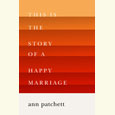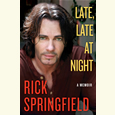More Than One Life
Lee Smith discusses the challenges and pleasures of writing—and living—over the long haul
Lee Smith is something of a ringer. Her many novels and short stories may at first appear to feature merely charming Southern hallmarks—the landscapes and tales of Appalachia, put-together ladies who sometimes get feisty, and skirmishes between propriety and desire. These traditional Southern elements do suffuse Smith’s work, but like any master storyteller, she pushes far beyond the surface of her materials. Smith’s characters also wrestle with their messy internal lives. At times they are filled with pathos; at others, they sparkle with wicked humor. These conflicts resonate as they unfold through dynamic storytelling. Smith crafts fictional worlds that can remake the familiar into something new, and the narrative voices of these remade Southern worlds blaze with empathy, precision, and wit. Her works vary from complex, multi-perspective novels like Oral History and The Devil’s Dream to four collections of short stories, including her most recent book, Mrs. Darcy and the Blue-Eyed Stranger.
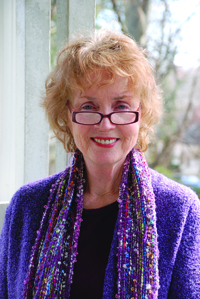
Smith grew up surrounded by “real storytellers” in the coal-mining town of Grundy, Virginia—an oral tradition that has echoed throughout her work. (In addition to her work as a fiction writer, Smith is the editor of Sitting on the Courthouse Bench, an oral history of Grundy.) After studying at Hollins University, she did stints as a newspaper reporter and teacher, including one at Nashville’s Harpeth Hall School. She now lives and works in Hillsborough, North Carolina, with her husband, nonfiction writer Hal Crowther.
Smith is a member of the Fellowship of Southern Writers and the North Carolina Literary Hall of Fame and has received numerous awards, like the Robert Penn Warren Prize, the Thomas Wolfe Award, and the Lifetime Literary Achievement Award from the State of Virginia. A musical called Good Ol’ Girls, which premiered Off Broadway in 2010, is based in part on Smith’s stories. Her thirteenth novel, Guests on Earth, will be published this October.
Prior to her appearance at the University of Memphis on February 21, Smith answered questions from Chapter 16 via email:
Chapter 16: Describing your lifelong devotion to stories, you once wrote, “Narrative is as necessary to me as breathing, as air.” As you have grown and changed over the years, has your relationship to narrative also changed in any way? Specifically, do stories now play any new roles for you that perhaps you hadn’t yet discovered as a younger writer?
Lee Smith: Narrative is still “as necessary to me as air,” and as natural as breathing. Perhaps this is because I started writing when I was very young; it’s just what I do. I write fiction the way other people write in their journals, I think. It has always been the way I register my life, the way I try to make sense of it. Of course I am not my characters—though often they are going through some of the same things I was going through when I wrote that particular story. I can read over an old story and remember exactly who I was—and where I was, and what I was dealing with—when I wrote it. But my stories now are very different from my earlier ones, just as I am very different from the young woman who wrote them.
Young writers’ stories are often more like poems: they’re writing straight out of the great dramas and traumas of their childhood, going for intensity. At my age now, I am more interested in the “long haul” than the epiphany. So my later stories, such as “House Tour” or “Stevie and Mama” (my favorite!) from my recent collection Mrs. Darcy and the Blue-Eyed Stranger are really about long marriages, how they change over time, and the relationship of the past to the present. I could never have written either of those stories when I was young. Now, writing stories is often a way of remembering rather than exploring. Time itself has become a huge theme for me: aging, the difference between expectation and reality, the reliability of memory, the relevance of history…. And I read a lot more history than I used to.
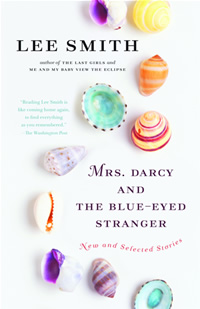 Chapter 16: Your characters are often propelled into conflict by thundering amounts of change. Some, like Ora Mae in Oral History, are older women reflecting on decades of personal and cultural change. Others, like Karen in “Tongues of Fire” or Jenny in “Live Bottomless,” are young girls bombarded by upheavals of family and identity. Though they often can’t control these huge forces, they try to make sense of their lives as best they can. What makes characters caught in moments of great change yield such compelling storylines?
Chapter 16: Your characters are often propelled into conflict by thundering amounts of change. Some, like Ora Mae in Oral History, are older women reflecting on decades of personal and cultural change. Others, like Karen in “Tongues of Fire” or Jenny in “Live Bottomless,” are young girls bombarded by upheavals of family and identity. Though they often can’t control these huge forces, they try to make sense of their lives as best they can. What makes characters caught in moments of great change yield such compelling storylines?
Smith: This is an interesting question which goes straight to the heart of writing fiction. I once heard the great writer Doris Betts teaching a class at the University of North Carolina in which she said that before she began writing a story or a novel, she always spent a lot of time thinking about her characters and imagining their lives, “until I know what they are doing and thinking at every moment during every regular day of their lives.” Then, she said, “I write the story about the day on which something different happens.”
Think about it—something different. That is, the possibility of change enters the world of the story, either within the mind of a character (he is a minister who has lost his faith, for instance) or within his environment (the bank has threatened foreclosure, or he has come into a unexpected fortune, or his daughter has announced her solo pregnancy, or an attractive neighbor has just asked him to help her carry some boxes as she moves in next door). The day on which something different happens—this is as good a description as I have ever heard concerning the importance of conflict in fiction. The fact is, conflict is the one element which separates fiction from every other kind of prose narrative. We have got to have it. Conflict is that element which captures our reader, engages him, and keeps him turning those pages; suspense depends upon conflict. So yes, my characters are always facing change—I try to grab them at those turning points in their lives after which things will never, ever be the same again.
Chapter 16: How do you go about developing the voice in a first-person narrative?
Smith: I grew up in a family of real storytellers. And because my very first sense of a story was oral, not written, stories have always come to me in a human voice—not always the voice of the main character, but sometimes the voice of the story itself. It’s like somebody is whispering the story in my ear. In particular, the first-person narrative voice comes to me very easily—perhaps too easily. So before I start writing, I have to make sure that this voice has got something valid to say. I need to figure out the plot, too, because I know from experience that if I don’t, the voice may just simply take over.
I go at these stories somewhat like Method Acting.
I go at these stories somewhat like Method Acting—I call it pre-writing. I spend a lot of time with a pencil and a legal pad, jotting down everything in the world about my narrator—how old is he, or she, now? Where did he grow up? Was he a happy child? What was his family like? What is the most traumatic thing that ever happened to him? What about his education, financial situation, love life? What does he want the most right now? Fear the most? Love the most? Hate the most? Is he religious? Political? And on and on and on, until this narrator, this guy—or girl—is literally walking around in my head, a real person. Then—and only then—will I let him start whispering his story in my ear. And by then, my narrator is really ready to talk! It’s all I can do to keep up. It’s like taking dictation.
Chapter 16: In your essay “Driving Miss Daisy Crazy; or, Losing the Mind of the South,” you acknowledge that Southern writers who grew up steeped in traditional elements of Southern literature—eccentric relatives, for example, or hometowns soaking in history and myth—must confront the fact that these core aspects of their own material “may already be trite.” As a Southern writer of such origins yourself, how do you outfox the clichés?
Smith: This is one of the biggest dilemmas which new writers or young writers—especially those who grew up, as I did, in traditional rural or small-town Southern settings— have to face. On the one hand, their writing teachers are telling them, “Write what you know”—that old saw, true as ever, since what you know (your own real life) will most likely be the truest and most compelling material you will ever have access to. On the other hand, what if your own experience has already been written about by a number of the best writers in the world, so that the details of your life are already trite before you even start out?
Let’s imagine that you are an aspiring young Appalachian writer whose father really does work in a coal mine, who really does have a granny who sits on the porch dipping snuff or smoking a pipe and coming up with wise sayings, whose mother really does speak in tongues, whose sister really is promiscuous, whose crazy uncle really does live up in the attic—what if he really does have a possum for a pet? Due as much to the media as to previous literature, Appalachian material is already a minefield of stereotypes. And the trouble with stereotypes is that they exist because they are so often true. But it is damn hard to put a pipe-smoking granny or a pet possum into a novel these days and get away with it.
The trouble with stereotypes is that they exist because they are so often true. But it is damn hard to put a pipe-smoking granny or a pet possum into a novel these days and get away with it.
So how can our young writer write what he knows and make it original? One approach is to use interesting language or narrative voice or inventive storytelling strategies—this is what I was trying to do when I wrote my novel Oral History using multiple speakers telling different sections of the novel, trusting the reader to piece it all together. Denise Giardina has often done the same thing in such novels as Storming Heaven and Unquiet Earth, as has Jayne Ann Philips most recently in Lark and Termite. Ann Pancake employed extremely innovative language in her novel Strange as This Weather Has Been which concerns mountaintop removal mining. This brings up another point: the young writer can write about a topical issue, such as mountaintop removal mining, which has not been dealt with widely before, because there is a new story every minute, in Appalachia as everywhere else. Many new stories about the environment and about drugs are coming out of Appalachia now—both pressing issues brilliantly addressed in recent years by Ron Rash and Silas House, among others. We can always make it new, but it takes close observation and some thought and ingenuity to do so.
Chapter 16: You seem to specialize in female characters who possess a keen sense of mischief, either as a natural-born trait or as a hard-won skill. Do you see this particular woman as a kind of Southern archetype? Or are you just especially drawn to characters who can’t help causing a bit of trouble?
Smith: My characters are braver than I am. They tend to live life passionately—“full tilt boogie,” that old phrase I’ve always loved. They are always making bad decisions and doing things I wouldn’t do. But they often voice my own thoughts and feelings, as well—though they tend to voice them more strongly than I dare to. And of course, they’re always in trouble, often some kind of “girl trouble” —I love that old phrase, too. So, you’re right: although I have written about all sorts of different characters, this single archetype probably recurs in my work more than any other. She’s the “good ol’ girl” —though she has gone through some hard times in her life, she’s still brave, honest, spunky, hard-working, hard-living and hard-loving, fiercely independent yet always loyal to her family. (She loves her kids, and she still calls her grandmother “Mamaw.”) This is the voice you often hear in country songs such as [Loretta Lynn’s] “You Ain’t Woman Enough (To Take My Man).”
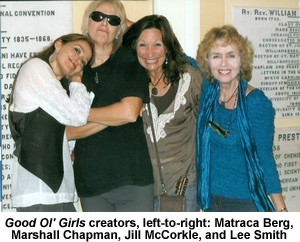 I love these girls! In fact, three good friends and I have put together a musical show named Good Ol’ Girls” featuring monologues and skits by Jill McCorkle and myself, songs by Nashville songwriters Matraca Berg and Marshall Chapman, all of it shaped into theater by playwright Paul Ferguson. Good Ol’ Girls was off-Broadway a couple of years ago and is now playing at other theaters around the country. I am so happy to say that it will be opening at the Barter Theater in Abingdon, Virginia, on August 18th.
I love these girls! In fact, three good friends and I have put together a musical show named Good Ol’ Girls” featuring monologues and skits by Jill McCorkle and myself, songs by Nashville songwriters Matraca Berg and Marshall Chapman, all of it shaped into theater by playwright Paul Ferguson. Good Ol’ Girls was off-Broadway a couple of years ago and is now playing at other theaters around the country. I am so happy to say that it will be opening at the Barter Theater in Abingdon, Virginia, on August 18th.
Chapter 16: Your first novel, The Last Day the Dogbushes Bloomed, was published forty-five years ago. How have you managed to sustain your own sense of curiosity and remain receptive to new creative possibilities over the long term?
Smith: Well, of course my characters have grown older along with me. I wrote the first version of that first novel, The Last Day the Dogbushes Bloomed, when I was still in college—it was my senior thesis at Hollins University. Its main character was a weird little overly-imaginative nine-year-old child—very much like the child I had been, growing up in Grundy, Virginia, when several of my best imaginary friends lived under a forsythia bush where my dog Missy and I used to visit them—hence the name “dogbushes.” I could still think like a nine-year-old when I was in my twenties. Now, with grandchildren older than that, I can’t.
I have used up my own childhood like I have used up my college experiences and most of my own adult life. But luckily that adult life has also included newspaper reporting and oral history work—both of these great open windows into other people’s lives, much more interesting than my own, anyhow. Actually there are not many writers these days whose book jackets can list exciting things like bush pilot, big-game hunter, or exotic dancer. No, more often we teach in writing programs, frankly. We have children; we have bills to pay.
So at some point in life we do have to stop writing about what we know, which is what they always told us to do in creative-writing classes, and write about what we can learn, and what we can imagine, and thus we come to know that great pleasure Anne Tyler alluded to when somebody asked her why she writes, and she said, “I write to have more than one life.” I do, too. And let me tell you, this has been the greatest pleasure, and the greatest privilege, in the world. I have spent my life writing about people I am not: housewives and whores, nineteenth-century schoolteachers, serpent handlers and lady evangelists, country-music singers and beauticians, for example, and most importantly, I think, about a lot of the older women in the mountains that I knew when I was growing up, women whose lives always seemed heroic to me. And I have had a wonderful time.
Chapter 16: What can you tell us about your upcoming novel, Guests on Earth?
Smith: The title Guests on Earth comes from a letter which Scott Fitzgerald wrote to his daughter Scottie in 1940: “The insane are always mere guests on earth, eternal strangers carrying around broken decalogues that they cannot read.” Of course we are all mere “guests on earth” as well—and this novel set in a famous mental hospital in the ’30s and ’40s intends to examine that very thin line between sanity and insanity. Who’s “crazy” and who’s not? What does that even mean?
I’m especially interested in women and madness—and in the resonance between art and madness, as well. Zelda Fitzgerald spent the last twelve years of her life as a psychiatric patient at Highland Hospital in Asheville, from 1936 to 1948 when she perished—along with eight other women—in one of the most disastrous hospital fires which has ever occurred. Her body was identified by her charred ballet slipper, for the brilliant and troubled Zelda was still a talented dancer as well as a writer and visual artist. In Guests on Earth I offer a solution to the unsolved mystery of the fire, along with a group of characters both imagined and real, and a series of events leading up to the tragedy. My narrator is a younger patient, a piano accompanist named Evalina Toussaint, who tells us at the beginning of the novel, “This is not my story then, in the sense that Mr. Fitzgerald’s The Great Gatsby was not Nick Carraway’s story either—yet Nick Carraway is the narrator, is he not? And is any story not always the narrator’s, in the end?”
[This article appeared originally on February 20,2013.]

